GMC SIERRA 1994 Manual Online
Manufacturer: GMC, Model Year: 1994, Model line: SIERRA, Model: GMC SIERRA 1994Pages: 404, PDF Size: 20.91 MB
Page 81 of 404
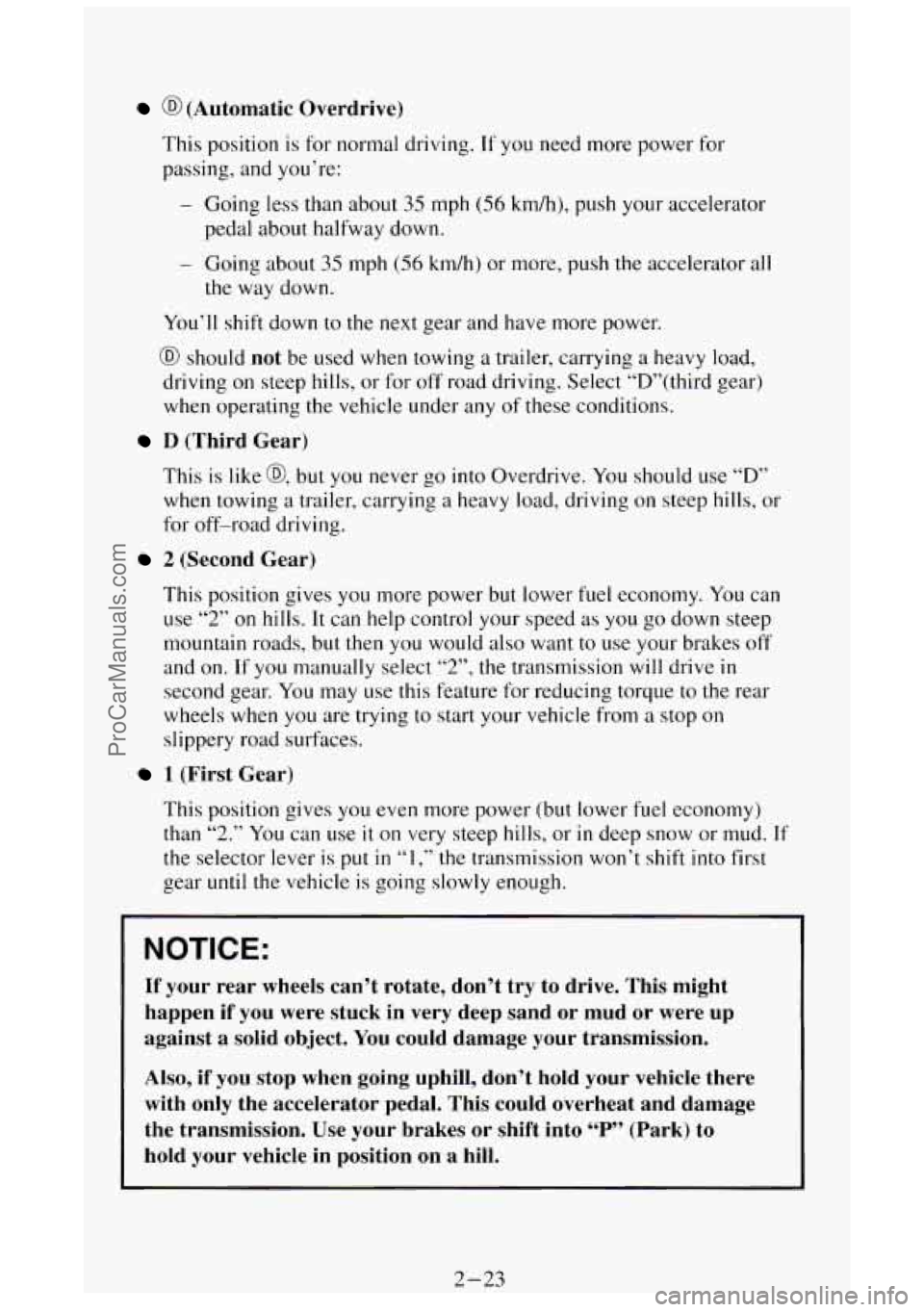
@ (Automatic Overdrive)
This position is for normal driving. If you need more power for
passing, and you’re:
- Going less than about 35 mph (56 km/h), push your accelerator
pedal about halfway down.
- Going about 35 mph (56 kdh) or more, push the accelerator all
the way down.
You’ll shift down to the next gear and have more power.
@ should not be used when towing a trailer, carrying a heavy load,
driving
on steep hills, or for off road driving. Select “D”(third gear)
when operating the vehicle under any
of these conditions.
D (Third Gear)
This is like @, but you never go into Overdrive. You should use “D”
when towing a trailer, carrying a heavy load, driving on steep hills, or
for off-road driving.
2 (Second Gear)
This position gives you more power but lower fuel economy. You can
use
“2” on hills. It can help control your speed as you go down steep
mountain roads, but then you would
also want to use your brakes off
and
on. If you manually select “2”, the transmission will drive in
second gear. You may use this feature for reducing torque to the rear
wheels when
you are trying to start your vehicle from a stop on
slippery road surfaces.
1 (First Gear)
This position gives you even more power (but lower fuel economy)
than
“2.” You can use it on very steep hills, or in deep snow or mud. If
the selector lever is put in “1 ,” the transmission won’t shift into first
gear
until the vehicle is going slowly enough.
b
NOTICE:
If your rear wheels can’t rotate, don’t try to drive. This might
happen if you were stuck in very deep sand or mud or were up
against
a solid object. You could damage your transmission.
Also,
if you stop when going uphill, don’t hold your vehicle there
with only the accelerator pedal. This could overheat and damage
the transmission. Use your brakes
or shift into “P” (Park) to
hold your vehicle in position on a hill.
2-23
ProCarManuals.com
Page 82 of 404

I
Five-Speed Manual Transmission
(With Low Gear)
This is your shift
pattern. Here’s how to
operate your
transmission:
L (Low Gear) is
intended only for
heavy loads and is not
recommended for
normal driving.
0 L (Low Gear) - Press the clutch pedal and shift into “L”. Then,
slowly let up on the clutch pedal as
you press the accelerator pedal.
Shift into
“L” only when the vehicle speed is below 5 mph (8 kdh). Tf
you try to shift into “L” at excessive vehicle speeds, the shift lever will
not move into the “L” position until vehicle speed is reduced.
0 1 (First Gear) - Press the clutch pedal and shift into “1.” Then,
slowly let up
on the clutch pedal as you press the accelerator pedal.
You can shift into “1” when you’re going less than 20 mph (32 km/h).
If you’ve come
to a complete stop and it’s hard to shift into “1,” put the
shift lever in “N” (Neutral) and let up on the clutch. Press the clutch
pedal back down. Then shift into
“I .” If you try to shift into “1” at
excessive vehicle speeds,
the shift lever will not move into the “1”
position until vehicle speed is reduced.
0 2 (Second Gear) - Press the clutch pedal as you let up on the
accelerator pedal and shift into “2.” Then, slowly let up on the clutch
pedal as
you press the accelerator pedal.
0 Higher Gears - Shift into the higher forward gears the same way you
do for
“2.” Slowly let up on the clutch pedal as you press the
accelerator pedal.
To Stop - Let up on the accelerator pedal and press the brake pedal.
Just before the vehicle stops, press the clutch pedal and the brake pedal,
and shift
to “N” (Neutral).
0 N (Neutral) - Use this position when you start or idle your engine.
R (Reverse) - To back up, first press down the clutch pedal. Wait
3-5 seconds for the internal parts to stop spinning and then, shift into
“R.” Let up on the clutch pedal slowly while pressing the accelerator
pedal.
2-24
ProCarManuals.com
Page 83 of 404
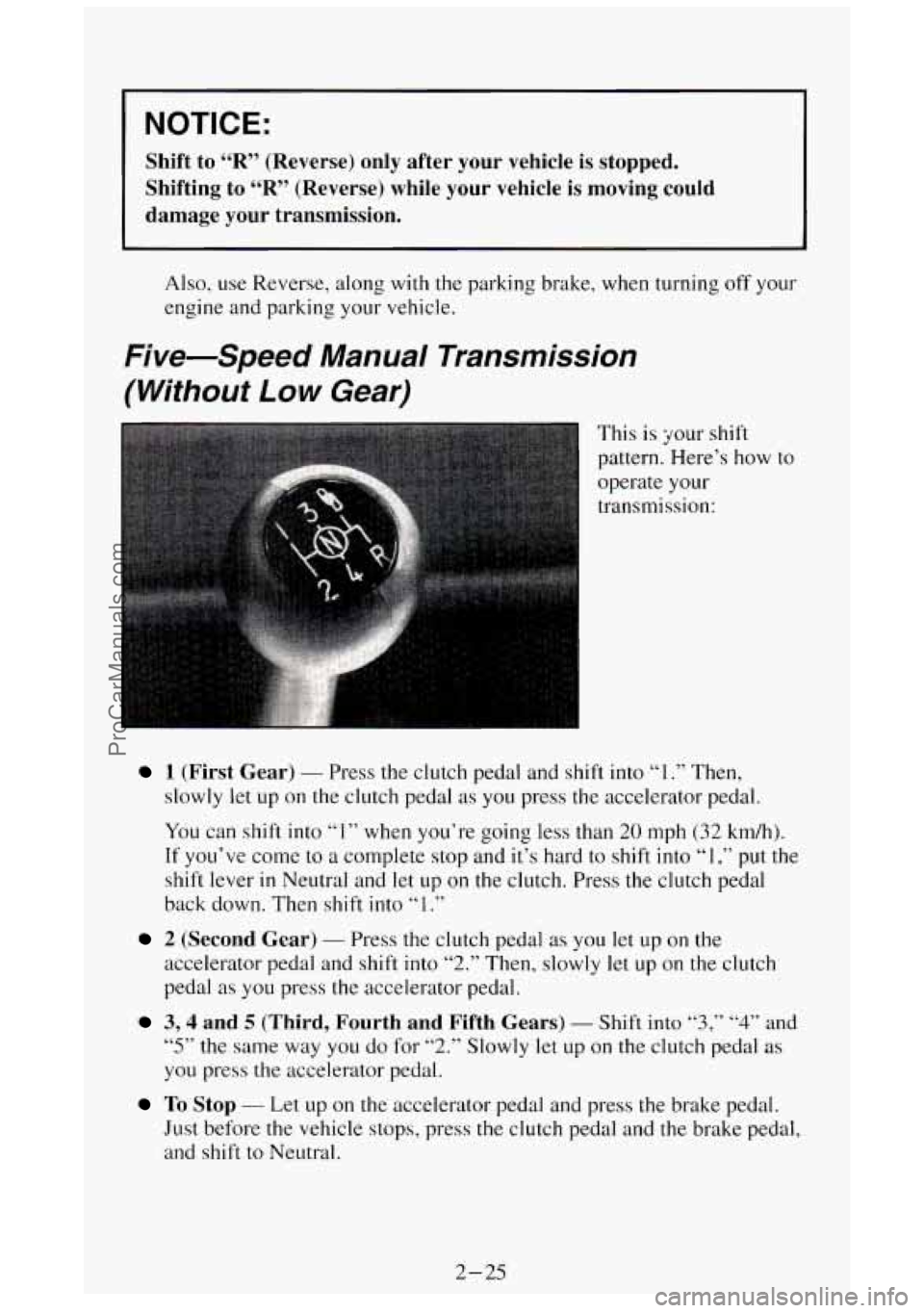
NOTICE:
Shift to “R” (Reverse) only after your vehicle is stopped.
Shifting
to “R” (Reverse) while your vehicle is moving could
damage your transmission.
Also, use Reverse, along with the parking brake, when turning off your
engine and parking your vehicle.
Five-Speed Manual Transmission
(Without
Low Gear)
This is your shift
pattern. Here’s how to
operate your
transmission:
1 (First Gear) - Press the clutch pedal and shift into “1 .” Then,
slowly
let up on the clutch pedal as you press the accelerator pedal.
You can shift into
“1” when you’re going less than 20 mph (32 km/h).
If you’ve come to a complete stop and it’s hard to shift into L‘ 1 ,” put the
shift lever
in Neutral and let up on the clutch. Press the clutch pedal
back down. Then shift
into LLl.”
2 (Second Gear) - Press the clutch pedal as you let up on the
accelerator pedal and shift
into “2.” Then, slowly let up on the clutch
pedal as
you press the accelerator pedal.
3,4 and 5 (Third, Fourth and Fifth Gears) - Shift into “3,” “4” and
“5” the same way you do for “2.” Slowly let up on the clutch pedal as
you press the accelerator pedal.
To Stop - Let up on the accelerator pedal and press the brake pedal.
Just before the vehicle stops, press
the clutch pedal and the brake pedal,
and shift to Neutral.
2-25
ProCarManuals.com
Page 84 of 404
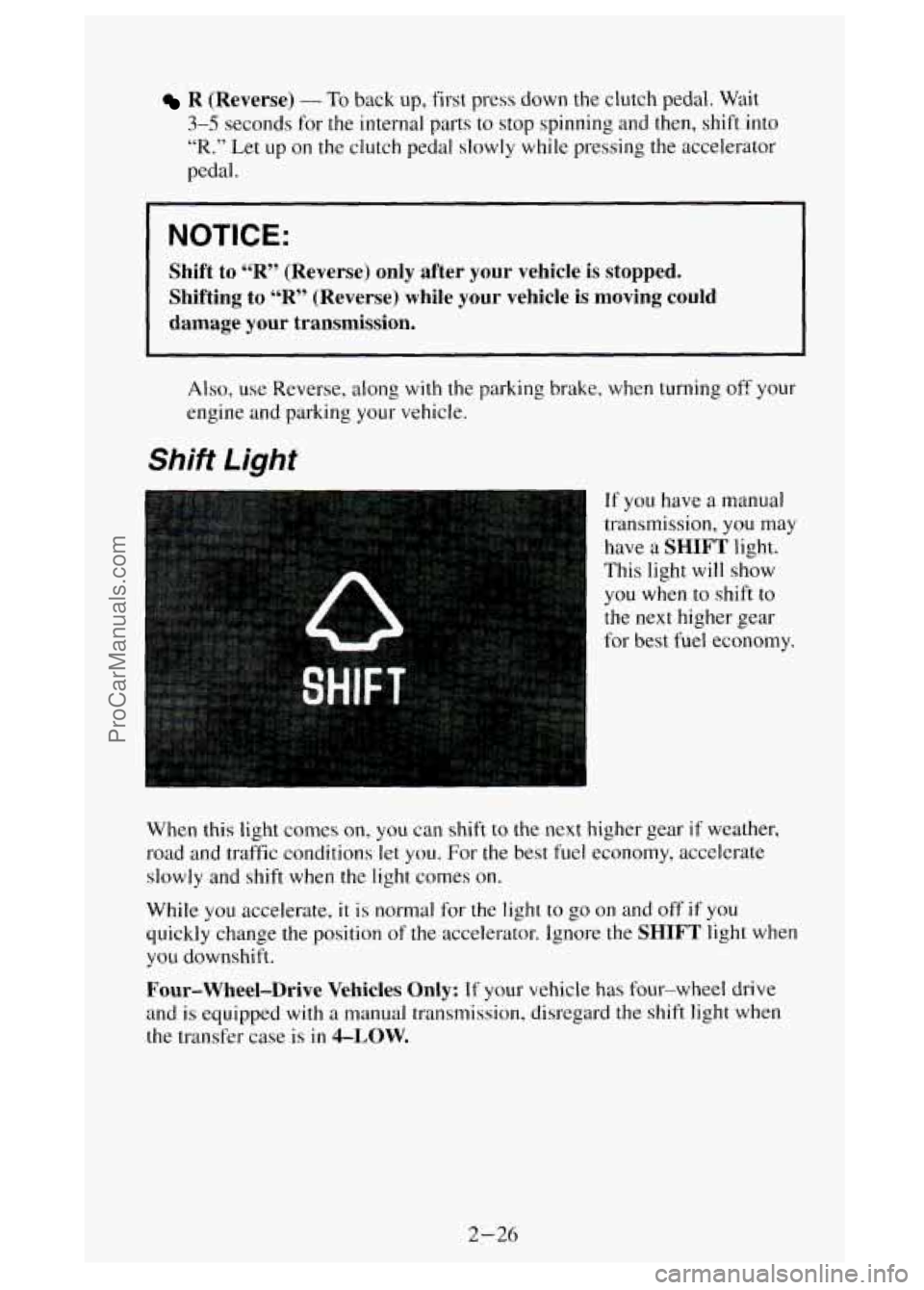
R (Reverse) - To back up, first press down the clutch pedal. Wait
3-5 seconds for the internal parts to stop spinning and then, shift into
“R.” Let up on the clutch pedal slowly while pressing the accelerator
pedal.
NOTICE:
Shift to “R” (Reverse) only after your vehicle is stopped.
Shifting to
LLR” (Reverse) while your vehicle is moving could
damage your transmission.
Also, use Reverse, along with the parking brake, when turning off your
engine and parking your vehicle.
Shift Light
If you have a manual
transmission,
you may
have
a SHIFT light.
This light will show
you when
to shift to
the next higher gear
l for best fuel economy.
I
When this light comes on, you can shift to the next higher gear if weather,
road and traffic conditions let you. For
the best fuel economy, accelerate
slowly and shift when the light comes on.
While you accelerate, it
is normal for the light to go on and off if you
quickly change the position
of the accelerator. Ignore the SHIFT light when
you downshift.
Four-Wheel-Drive Vehicles Only: If your vehicle has four-wheel drive
and is equipped with
a manual transmission, disregard the shift light when
the transfer case is in 4-LOW.
2-26
ProCarManuals.com
Page 85 of 404
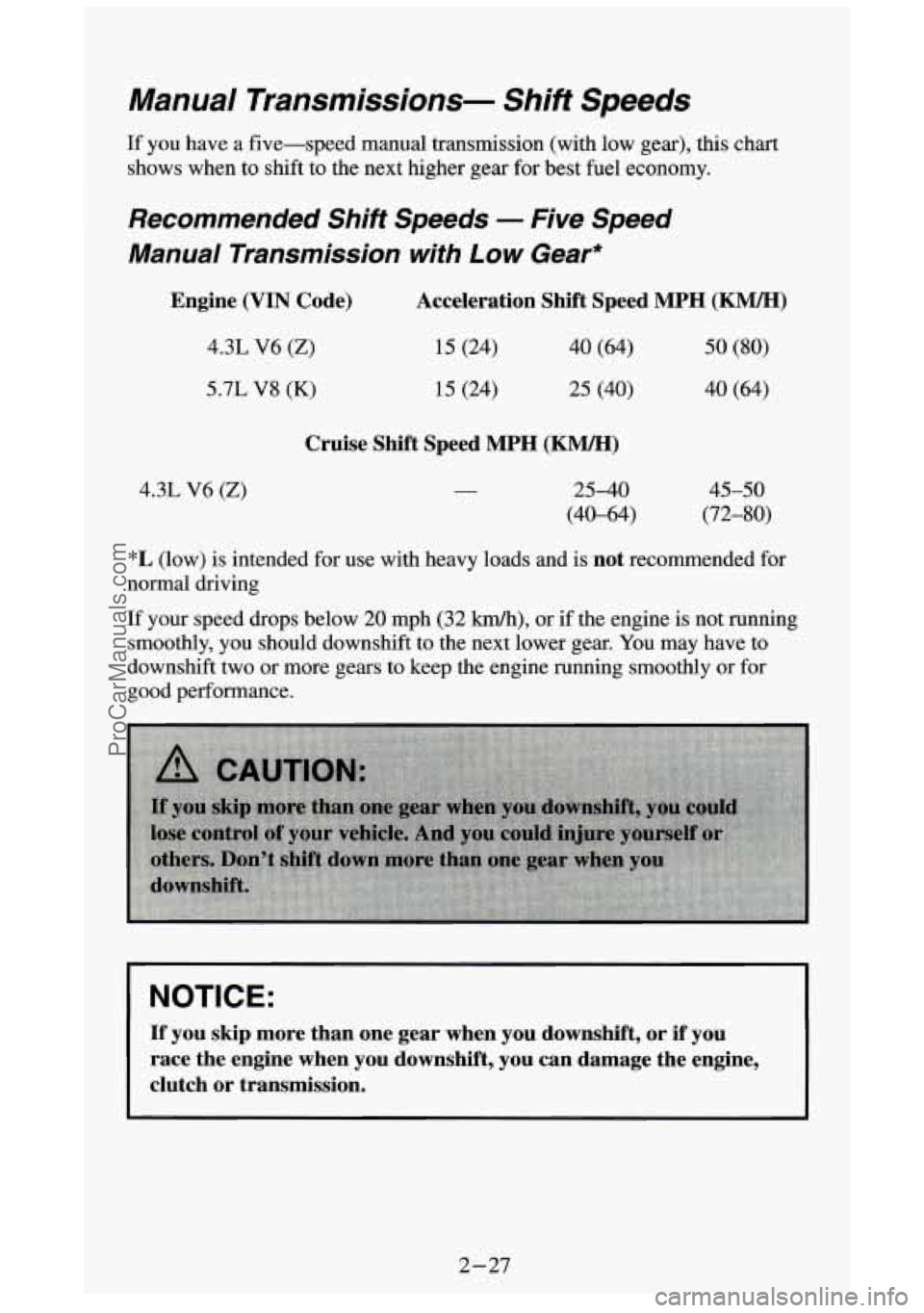
Manual Transmissions- Shift Speeds
If you have a five-speed manual transmission (with low gear), th\
is chart
shows when to shift to the next higher gear for best fuel economy.
Recommended Shift Speeds - Five Speed
Manual Transmission
with Low Gear*
Engine (VIN Code)
4.3L V6 (Z)
5.7L V8 (K)
4.3L V6 (Z)
Acceleration Shift Speed MPH (KM/H)
15 (24)
15 (24) 40 (64)
25 (40)
Cruise Shift Speed MPH (KM/H)
25-40
(40-64) 50
(80)
40 (64)
45-50
(72-80)
*L (low) is intended for use with heavy loads and is not recommended for
normal driving
If your speed drops below
20 mph (32 km/h), or if the engine is not running
smoothly, you should downshift to the next lower gear. You may have to
downshift two or more gears to keep the engine running smoothl\
y or for
good performance.
NOTICE:
If you skip more than one gear when you downshift, or if you
race the engine when you downshift, you can damage the engine,\
clutch or transmission.
2-27
ProCarManuals.com
Page 86 of 404
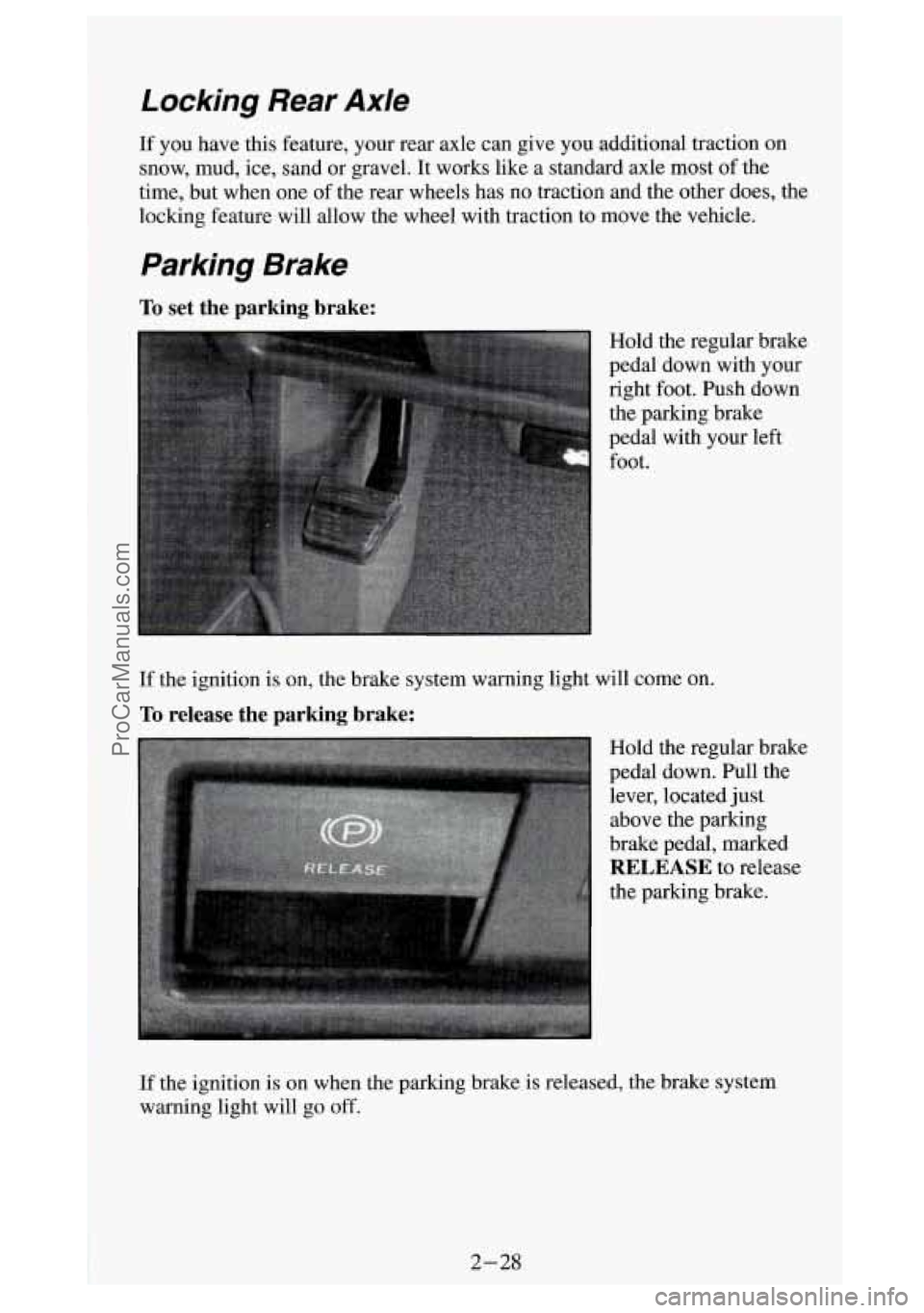
Locking Rear Axle
If you have this feature, your rear axle can give you additional traction on
snow, mud, ice, sand or gravel. It works like a standard axle most of the
time, but when one
of the rear wheels has no traction and the other does, the
locking feature will allow the wheel with traction to move the vehicle.
To set the parking brake:
Hold the regular brake
pedal down with your
right foot. Push down the parking brake
pedal with your left
foot.
If the ignition is on, the brake system warning light will come on.
To release the parking brake:
Hold the regular brake
pedal down. Pull the lever, located just
above the parking
brake pedal, marked
RELEASE to release
the parking brake.
-
If the ignition is on when the parking brake is released, the brake system
warning light will
go off.
ProCarManuals.com
Page 87 of 404
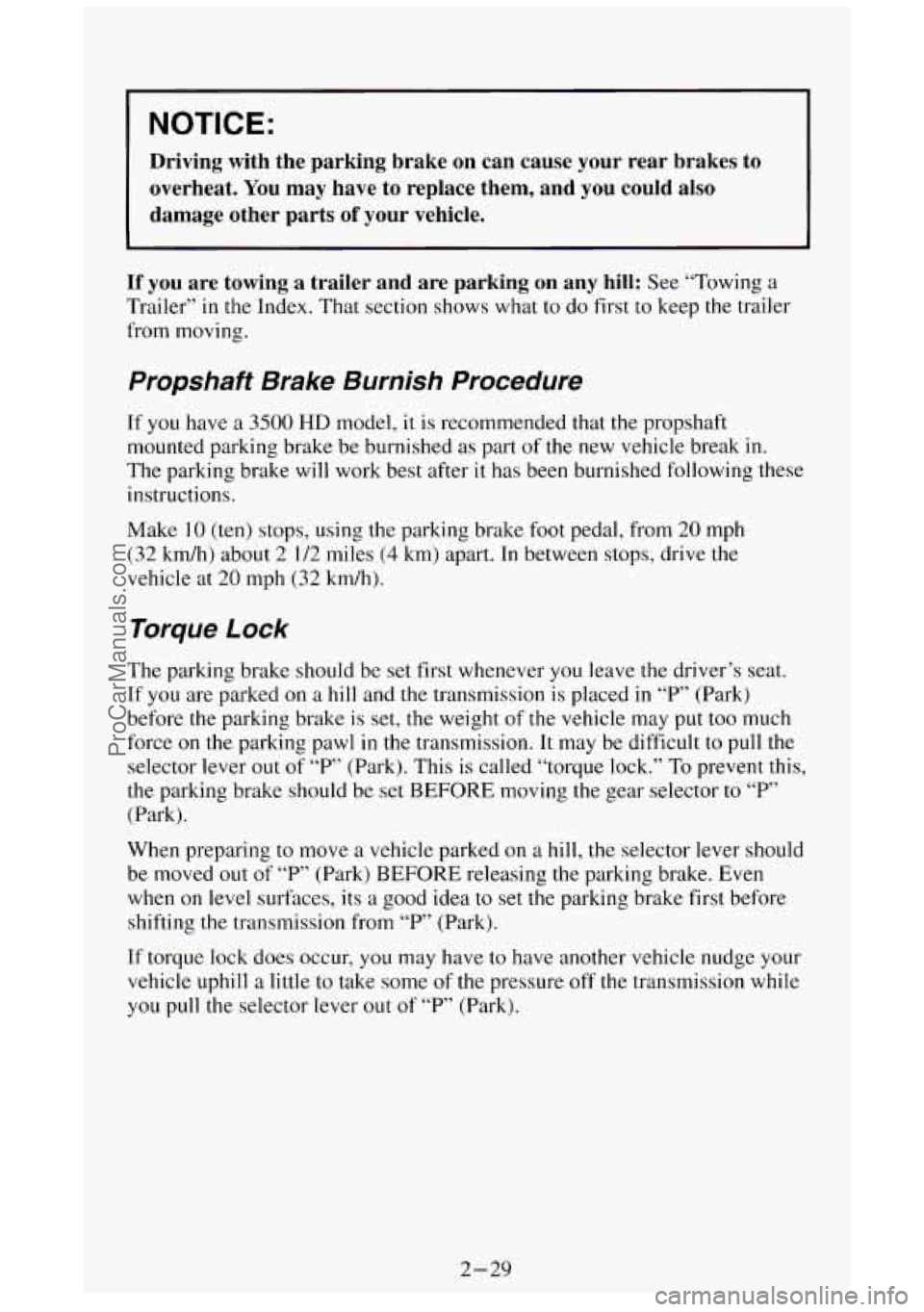
NOTICE:
Driving with the parking brake on can cause your rear brakes to
overheat. You may have
to replace them, and you could also
damage other parts of your vehicle.
If you are towing a trailer and are parking on any hill: See “Towing a
Trailer” in the Index. That section shows what to do first to keep the trailer
from moving.
Propshaft Brake Burnish Procedure
If you have a 3500 HD model, it is recommended that the propshaft
mounted parking brake be burnished
as part of the new vehicle break in.
The parking brake will work best after it has been burnished following these
instructions.
Make
10 (ten) stops, using the parking brake foot pedal, from 20 mph
(32 kdh) about
2 1/2 miles (4 km) apart. In between stops, drive the
vehicle at
20 mph (32 km/h).
Torque Lock
The parking brake should be set first whenever you leave the driver’s seat.
If you are parked on
a hill and the transmission is placed in “P” (Park)
before
the parking brake is set, the weight of the vehicle may put too much
force
on the parking pawl in the transmission. It may be difficult to pull the
selector lever out
of “P’ (Park). This is called “torque lock.” To prevent this,
the parking brake should be set
BEFORE moving the gear selector to “P’
(Park).
When preparing to move
a vehicle parked on a hill, the selector lever should
be moved out of
“P’ (Park) BEFORE releasing the parking brake. Even
when
on level surfaces, its a good idea to set the parking brake first before
shifting
the transmission from “P” (Park).
If torque lock does occur, you may have to have another vehicle nudge your
vehicle uphill a little to take some
of the pressure off the transmission while
you pull the selector lever out of “P” (Park).
2-29
ProCarManuals.com
Page 88 of 404
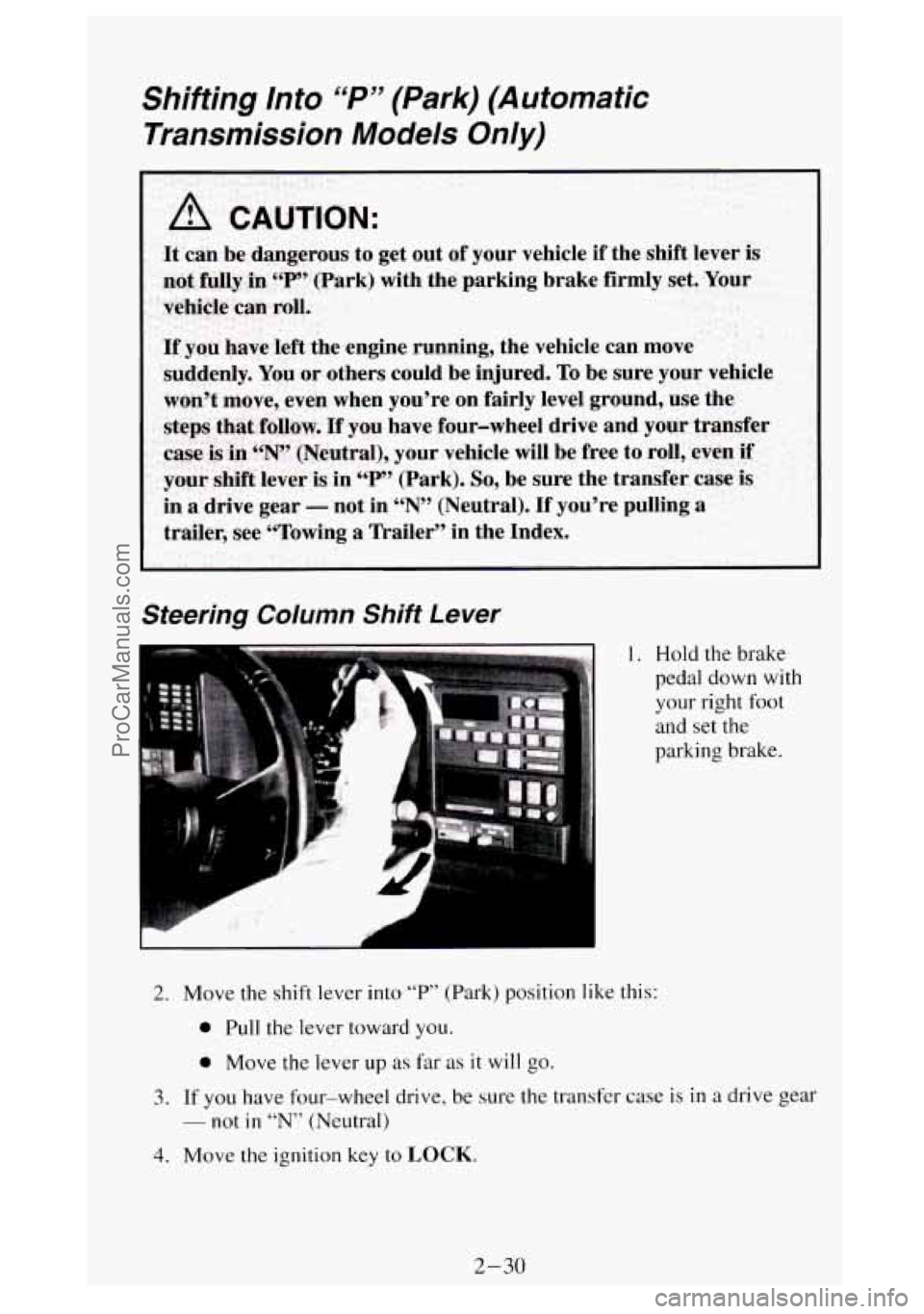
Shifting Into “P” (Park) (Automatic
Transmission Models Only)
Steering Column Shift Lever
1. Hold the brake
pedal down
with
your right foot
and set the
parking brake.
2. Move the shift lever into “P” (Park) position like this:
0 Pull the lever toward you.
0 Move the lever up as far as it will go.
3. If you have four-wheel drive, be sure the transfer case is in a drive gear
- not in “N” (Neutral)
4. Move the ignition key to LOCK.
2-30
ProCarManuals.com
Page 89 of 404
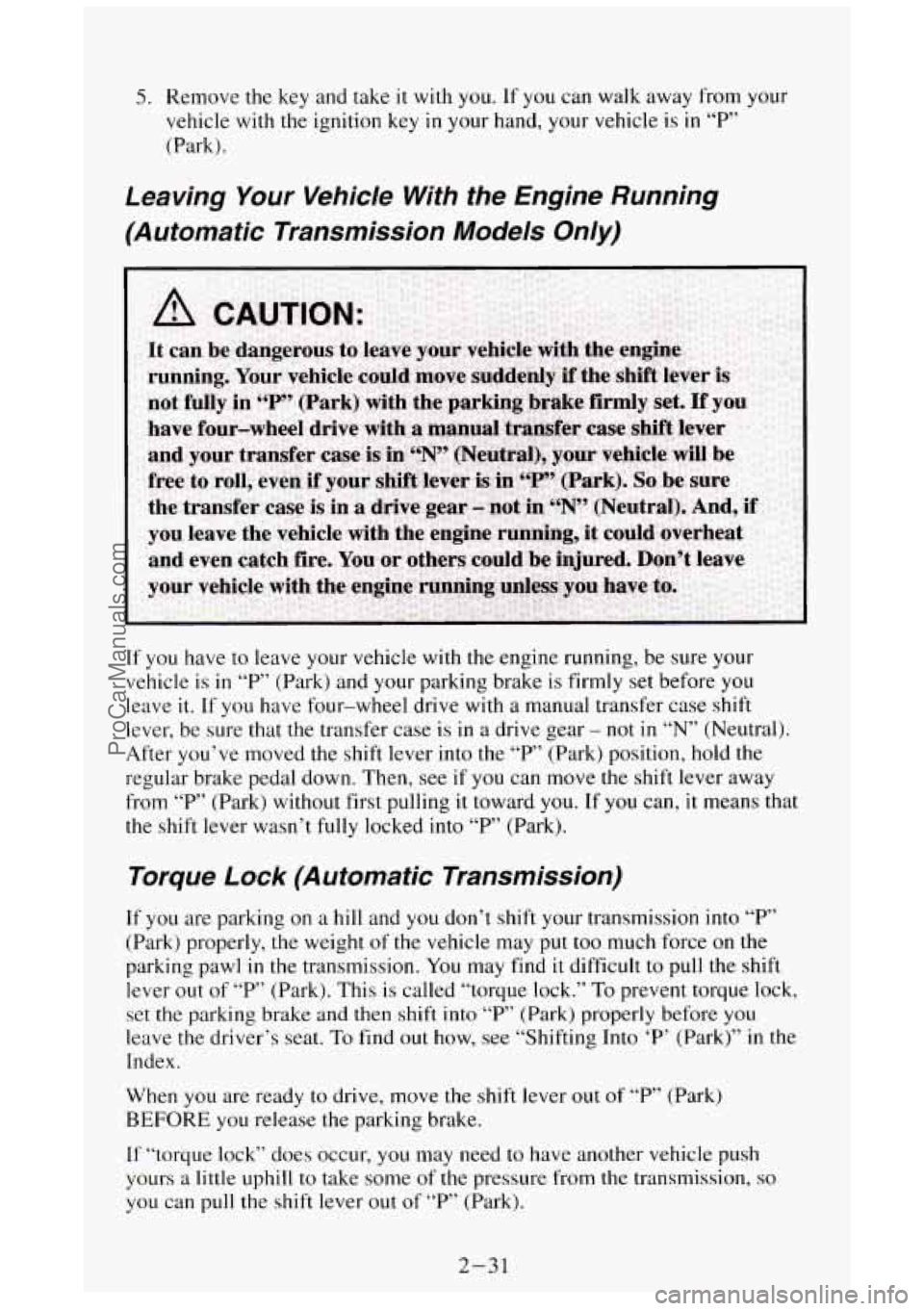
5. Remove the key and take it with you. If you can walk away from your
vehicle with
the ignition key in your hand, your vehicle is in “P”
(Park).
Leaving Your Vehic/e With the Engine Running
(Automatic Transmission Models Only)
If you have to leave your vehicle with the engine running, be sure your
vehicle is
in “P” (Park) and your parking brake is firmly set before you
leave it. If you have four-wheel drive with a manual transfer case shift
lever, be sure that the transfer case
is in a drive gear - not in “N” (Neutral).
After you’ve moved the
shift lever into the “P’ (Park) position, hold the
regular brake pedal down. Then, see if
you can move the shift lever away
from “P” (Park) without first pulling it toward
you. If you can, it means that
the shift lever wasn’t
fully locked into “P” (Park).
Torque Lock (Automatic Transmission)
If you are parking on a hill and you don’t shift your transmission into “P”
(Park) properly,
the weight of the vehicle may put too much force on the
parking pawl
in the transmission. You may find it difficult to pull the shift
lever out of
“P’ (Park). This is called “torque lock.” To prevent torque lock,
set the parking brake and then shift into “P’ (Park) properly before you
leave
the driver’s seat. To find out how, see “Shifting Into ‘P’ (Park)” in the
Index.
When you are ready to drive, move the
shift lever out of “P” (Park)
BEFORE you release the parking brake.
If “torque
lock” does occur, you may need to have another vehicle push
yours
a little uphill to take some of the pressure from the transmission, so
you can pull the shift lever out of “P’ (Park).
2-31
ProCarManuals.com
Page 90 of 404
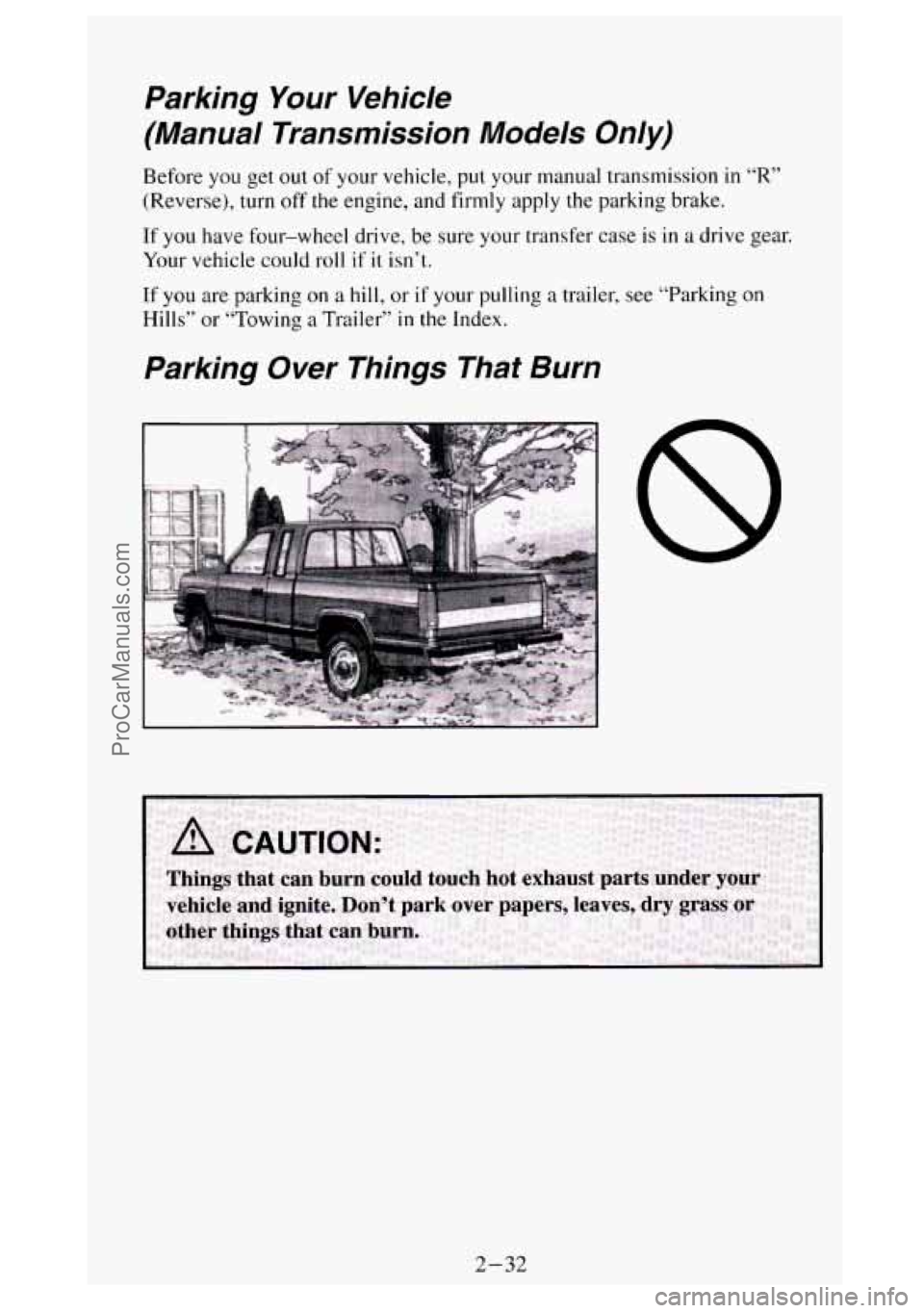
Parking Your Vehicle
(Manual Transmission Models
Only)
Before you get out of your vehicle, put your manual transmission in “R”
(Reverse), turn off the engine, and firmly apply the parking brake.
If you have four-wheel drive, be sure your transfer case is in a drive gear.
Your vehicle could roll
if it isn’t.
If
you are parking on a hill, or if your pulling a trailer, see “Parking on
Hills” or “Towing a Trailer” in the Index.
Parking Over Things That Burn
2-32
ProCarManuals.com